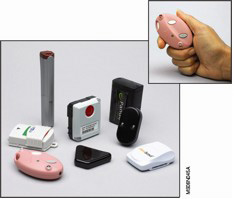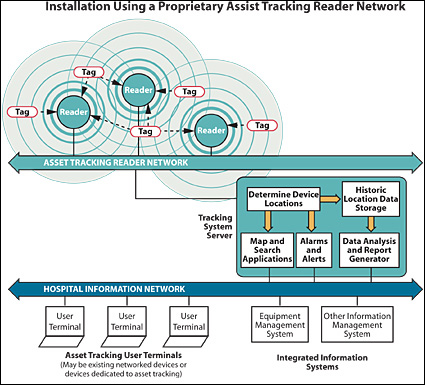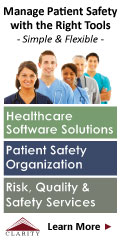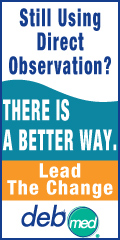 |
 |
 |

May / June 2007

Asset Tracking Systems: Readiness and
Selection Factors
By James P. Keller, Jr. MS
Many hospitals have been considering a new technology that is often referred to as RFID (radio frequency identification). The technology can be used to track the location of medical devices needed for inspections or repairs, and it can also be used to find equipment needed for clinical procedures. RFID can track the location of patients as they work their way through the hospital, and it can also keep track of the location of clinical staff. All of these applications are designed to improve hospital efficiency, decrease costs, and ideally improve patient safety (e.g., by helping hospitals locate recalled devices more quickly).
RFID is actually just one of the technologies used for locating these tasks. Other technologies used for the same purposes include infrared and ultrasound detection. This article will discuss RFID and other technologies used for general locating applications. For the purpose of this article, the technology is more generally referred to as asset tracking. This article is adapted from an ECRI guidance article (with permission from ECRI) on asset tracking that was published in the October 2006 issue of ECRI's Health Devices journal. This article will describe the different type of asset tracking applications — with a particular focus on locating of medical equipment — and issues hospitals should consider before investing in asset tracking systems.
Asset tracking refers to the ability to detect, identify, and locate assets — such as a particular medical device — essentially in real time, and to record the physical locations of those assets over time. Computerized systems for performing this function, though well established in some other industries, are just now being introduced in healthcare. To date, a limited number of healthcare facilities have implemented asset tracking technology, and the marketplace is still rapidly evolving. Nevertheless, interest in this technology's application in healthcare is growing.
In addition to helping staff locate equipment, hospital asset tracking systems are often promoted as being able to help facilities optimize the use and distribution of inventory (e.g., by collecting and facilitating the analysis of data on equipment location over time). While many current tracking systems do facilitate inventory optimization, the amount of effort required on the part of the hospital to realize such benefits can be substantial.
Of the healthcare facilities that have already implemented an asset tracking system, most have opted for relatively limited implementations, in which an asset tracking system is used to help clinicians or clinical engineering personnel locate devices more quickly. A few hospitals have attempted more ambitious inventory optimization efforts, with the goal of providing substantial hospital-wide cost savings. (Additional asset tracking applications, though possible, are not necessarily practical at this stage in the technology's development and have seldom been implemented.)
The reasons for implementing an asset tracking system can be diverse. Thus, the key to making successful decisions about this technology — including whether it's worth pursuing at this time — is for a healthcare institution to clarify its objectives for an asset tracking system. This means identifying what hospital staff want the system to do and what gains they hope to realize.
Technology Overview
| |

 |
Figure 1 — Typical asset tracking tags
Reprinted with permission from ECRI |
Asset tracking systems locate items through the use of tags and readers. Tags used for hospital asset tracking are small, battery-powered objects that are attached to the items to be tracked. These tags periodically emit signals that are detected by readers located in ceilings or on walls in the tracking area. The data from the readers is then sent to one or more computers (servers), where locating algorithms are used to determine the device location. Sample asset tracking tags are shown in Figure 1.
In addition to incorporating locating algorithms, asset tracking systems provide an interface for users to identify, track, and search for the location of assets. Users access the interface through a computer connected to the hospital's network. Depending on the system's capabilities and how it is configured, location information about specific equipment can then be displayed on-screen, often in tables or on floor plan maps. For example, a clinician looking for an infusion pump might call up a map of the care area that illustrates where a pump can be found. Information about each device — such as model number, manufacturer, and sometimes maintenance schedule — can also be linked to the tag and displayed with the location. Figure 2 represents a typical implementation of an asset tracking system.


Figure 2 — Typical asset tracking configuration
Reprinted with permission from ECRI
Establishing wireless communication between tags and readers can be accomplished in a variety of ways. Today, asset tracking systems are most often based on one of the following technologies:
- Infrared (IR) technology

- Radio-frequency (RF) technology — including narrowband radio-frequency identification (RFID) and ultra-wideband (UWB) technologies, as well as wireless fidelity (Wi-Fi) technology

- A combination of IR and RF technologies

- Ultrasound technology
Each of these alternatives offers advantages and disadvantages. One significant consideration is that most of the technologies use proprietary reader networks that must be installed in the tracking area. Such networks often require considerable expense and inconvenience to install. An exception is Wi-Fi, which can make use of an existing (or planned) hospital standard wireless local area network (WLAN) infrastructure.
Decision Making
While the general functionality described above is common to most healthcare asset tracking systems, the systems offered by the various suppliers can differ substantially from one another. In fact, even individual systems can differ from one installation to the next, as systems are typically tailored to meet the needs and circumstances of individual facilities. Similarly, there can be significant differences among the suppliers that offer these systems. Understanding these differences will help a facility define its needs, determine whether asset tracking is appropriate, and if so, select an appropriate system. Following are a few questions that healthcare organizations should consider when determining whether to invest in an asset tracking system:
- What applications can a supplier's system be used for?

- What underlying technology is used, and what are its advantages and disadvantages for the intended application?
About the supplier:
- How much experience does the supplier have with healthcare asset tracking? For example: How long have its tracking products been marketed for healthcare applications? How many of a specific system have been successfully implemented? What is the scale of these installations? Where in the hospital (e.g., emergency department, operating suite) have the systems been implemented?

- Does the supplier emphasize a particular application or applications? Though it may be theoretically possible to use most systems for any application, the supplier may have included certain features or otherwise optimized its system for specific applications.

- What type of product or service does the supplier offer? Some suppliers offer only certain components, some integrate other suppliers' products, but don't produce any components themselves, and some offer a complete solution package.
About your needs:
- What assets do you want to track? For example, do you want to track all mobile assets, or just specific classes of assets, (e.g., infusion pumps, wheelchairs)?

- Where will tracking take place? That is, do you want broad coverage throughout the facility, or will the system be limited to certain departments or locations?
Defining Applications
Once a tracking network has been established, the technology can, in theory, be used to track virtually anything or anyone in that area, as long as a tag can be affixed to or carried by the object or person. In practice, however, the healthcare facility will want to narrow the use of its system — for example, using it to track only specific kinds of assets. Mobile clinical devices, particularly those that are needed often, are typically good candidates for tracking.
The choice of assets to be tracked will depend on the intended application of the asset tracking system and the specific requirements of the individual hospital. For example, a hospital that sees the need to help clinicians locate devices that have historically been difficult to find or that are most often needed urgently might want to tag those devices and then provide clinicians with ready access to the asset tracking system (e.g., through computers in the care area). Similarly, hospitals that wish to improve the efficiency of their equipment inspection and preventive maintenance (IPM) processes or achieve higher IPM completion rates could tag all mobile assets on the IPM schedule or could tag only the assets that have been most difficult to find.
Infusion pumps are currently the most commonly tagged items. These devices are used frequently in patient care, they are moved about the hospital (e.g., to different patient care areas and to locations for cleaning after use), and they are often hoarded, making them difficult to locate at times. Thus, a locating system for these devices could be extremely helpful, both for clinicians and for those clinical engineering departments that routinely inspect infusion pumps. Other commonly tagged items include wheelchairs, stretchers, beds, external pacemakers, electrocardiographs, telemetry transmitters, computers on wheels (which are computers mounted on carts), portable ultrasound units, physiologic monitors, and noninvasive blood pressure monitors.
Disposable items are not usually tracked with these types of systems. With disposables, facilities are usually more interested in monitoring and controlling inventory levels than in tracking the location of particular supplies, and barcodes are more typically used for that purpose. (Although barcoding is sometimes marketed as an asset tracking technology, it is not suitable for hospital asset tracking because it does not help users locate an asset automatically. Barcoding does have other uses in the hospital, however.) Some replaceable components, such as ECG cables, can be considered for tracking because they are easily lost (e.g., when they leave the care area with the patient).
However, the cost and effort required for tagging must be justified by the expected benefits. That is, the cost of the tags, as well as the effort required to apply tags to new cables and to replace tag batteries when needed, should be considered before deciding on this application.
Recall Management
From a patient safety perspective, one of the most important applications for real-time equipment location is to minimize time-consuming searches for equipment that has been the subject of a hazard report or recall. In addition to yielding significant time savings, asset tracking systems can help ensure that all affected devices are located. If affected devices were not found in a timely manner, patient care or safety could be jeopardized, particularly in the case of serious device hazards and recalls. In addition, failure to locate all affected devices could jeopardize hospital compliance with Joint Commission on Accreditation of Healthcare Organizations (JCAHO) recall management or equipment maintenance requirements.
Of course before hospitals jump in to use an asset tracking for part of their hazard and recall management programs, they need to make sure that the devices they will be tracking are appropriately identified in their inventory databases. Making sure that a standard medical device nomenclature system is used in the inventory is a good first step. For example, ECRI produces a medical device hazard and recall notification system. Every report sent out by ECRI is linked to its Universal Medical Device Nomenclature System (UMDNS). If all defibrillators in a hospital's inventory and asset tracking system are using the same term and ideally a standardized system like UMDNS, then identifying and subsequently locating all defibrillators affected by a recall or hazard report will be much easier.
Perspectives
Asset tracking technology has tremendous potential to save time, improve workflow, save money, and significantly improve patient safety. However, this is a new technology that only a small number of hospitals have adopted to date. Those that have adopted the technology have expended a significant amount of staff resources and cost to put it in place. Also, there has been quite a bit of change in this technology and in the number of vendors that offer it in the short time that it has been marketed for healthcare. It is expected that as time goes on, this technology will be easier to implement and prices will come down. So, if hospitals do not have a compelling short-term need, they may want to consider waiting to adopt asset tracking systems while the technology and the marketplace matures.
James Keller is vice president of health technology ealuation and safety at ECRI. He may be contacted at jkeller@ecri.org.
References
ECRI. (2006, October). Asset tracking: What it is and whether it is right for you [Guidance Article]. Health Devices, 35(10), 365-386.
ECRI. (2006, November). Asset tracking systems [Evaluation]. Health Devices, 35(11), 397-419.
|
 |
 |
 |


















|
 |



